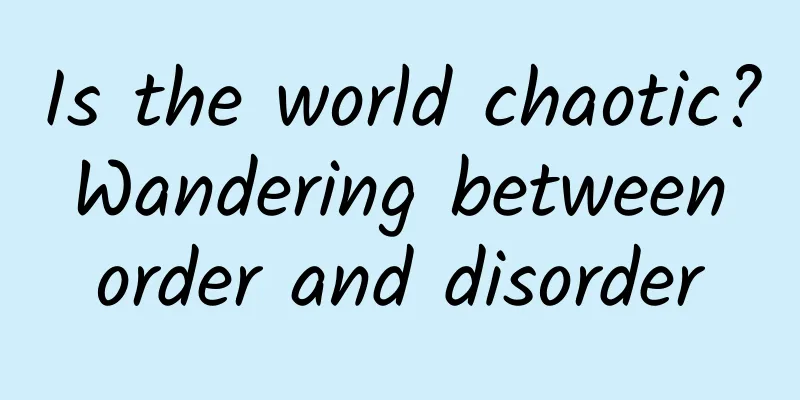Is the world chaotic? Wandering between order and disorder

|
Yang Mingzhe Introduction: Imagine we throw a stone into the sky, and it will definitely fall back down. If the whole world is made of stones that only need to be described by Newton's laws, it would be meaningless. Now replace the stone with a bird. What will happen if you throw a bird into the sky? It may avoid its predators, look for food, or fly to a habitat first. In short, we cannot accurately predict the behavior of this bird, but we are curious about what it will do. The reason why life in all its forms can continue to surprise us is precisely because of the topic we are going to talk about today - the edge of chaos. A World on the Edge of Chaos Chaos is random disorder and the unpredictable "butterfly effect", like the free movement of molecules in a gas; its antonym, order, means regularity and predictability, like the periodic regular arrangement of atoms in a crystal. The discussion about order and chaos has always been a concern for scientists from different disciplines. First, let's look at economics. In the last century, mainstream economists always admired mathematical formulas that describe equilibrium states and represented a sense of order, because order made them feel at ease, and the chaos that deviated from equilibrium was regarded as an exception. Among them, Brian Arthur , an outlier, has been thinking about real non-equilibrium economic phenomena, such as increasing returns and financial crises. In the field of biology, which is far away from the field of economics, biologists are busy with the complicated biological phenomena. No one believes that biological problems can be described and solved as simply as physics. Stuart Kaufman , a medical student who worships Einstein, has always been fascinated by the fact that the order of life can spontaneously emerge from autocatalysis. Such research is also not understood by his peers. When Arthur and Kaufman met, they were surprised to find that the chaos Arthur talked about and the order Kaufman was concerned about were essentially the same thing. We can draw a spectrum, with the left end of the spectrum representing order and the right end representing chaos. When a system moves from left to right on this spectrum, the degree of order decreases and the degree of chaos increases. Arthur is moving from left to right, while Kaufman is moving from right to left, and the two meet at the edge. Compared with the length of the entire spectrum, this edge is not spacious. But it is very important, just like the spectrum in physics, where visible light occupies only a small frequency range, but it is enough to construct a colorful visual world. Now, welcome to the world of Edge of Chaos. What is Edge of Chaos? If there is such a spectrum, what parameters determine where a system is on the spectrum? If the secret behind life is not its organic composition, but the organizational form that has something in common with economic systems, does that mean we can reproduce this "feeling of life" on computers? Computer scientist Christopher Langton and his most famous artificial life research help us answer these questions. Cellular automata are the simplest form of artificial life . Cellular automata consist of a regular grid of cells, each of which is initially in a state, such as life or death, corresponding to white or black, and then according to a set of certain local rules, it generates the state of the next moment, thus constantly being born and dying. Although the rules for the interaction between cells are simple, cellular automata evolve over time and can produce very diverse macroscopic behaviors, wandering between randomness and order. When playing this game, we can control the survival rate, that is, the proportion of cells that survive each generation. For example, a survival rate of 0 means that all cells in the cellular automaton die after running one generation. As the survival rate changes, the final state of the cellular automaton will be of four types: 1. Fixed point type: all cells are attracted to a fixed state; 2. Periodic: The system cycles between some fixed states; 3. Complex type: The system will have a very complex structure; 4. Chaotic type: The complex structure disappears and the system is attracted to a completely random chaotic state. When the survival rate is too large or too small, the entire cellular world will either fall into a monotonous fixed point or a periodic change between fixed points, or fall into a headache-inducing chaos. When the survival rate is in a subtle value in the middle, the cellular world will be full of vitality and will continue to emerge one after another. This is actually a phase transition phenomenon. This phase transition behavior of cellular automata is like the transition of water from solid to liquid. At first, cellular automata are like solid ice, very orderly but not fluid; as the temperature rises, the ice melts into liquid water, in a completely fluid state; and in this short transition from solid ice to liquid water, complex structures emerge - water molecules continue to combine into orderly structures, but this ordered structure will not be frozen, but will continue to collide and break, and new structures will continue to be generated. This state is called the " edge of chaos ." It was also Langton who invented the term edge of chaos. By the way, the story of Langton and the edge of chaos is described in more detail in the book "Complexity", and friends who are interested can read it. 3. Why are we on the edge of chaos? After understanding what the edge of chaos is, a natural question is, why is it? Why must a dynamic system be at the edge of chaos? We know that the evolution of organisms is governed by Darwin's theory of evolution, so the question becomes, why does Darwin's theory of evolution drive organisms to evolve to the edge of chaos ? The answer comes from another assertion of Langton: the system at the edge of chaos has the greatest computing power . The computing here is not just the arithmetic we talk about in our daily life. A system does not necessarily need to be conscious to calculate. Even the movement of a molecule under the control of physical laws can be regarded as doing a kind of calculation. A life instinctively seeking benefits and avoiding harm is also doing a calculation. Back to the example at the beginning of the video, when a stone simply reacts to the outside world according to Newton's laws, it is doing calculations, but these calculations are very simple; while the birds that fly out use a lot of internal calculations to determine their surprising behaviors. It can be imagined that life forms that can do a lot of complex calculations will definitely gain a greater advantage in the game of evolution. The survival of the fittest simulated on the computer also confirms this. What are the applications of Chaos Edge? So what is the purpose of inventing the concept of edge of chaos? In addition to helping us better understand life phenomena, can it be used to improve our lives? First of all, for leaders, it tells us that if we want to build an organization with strong survival ability and vitality, instead of top-down design, it is better to find key parameters to keep the organization at the edge of chaos so that it can continue to thrive. Furthermore, if we regard the entire market as a complex system, we should give up the expectation that there is an economic theory that can solve those important economic problems once and for all, because it is based on the unrealistic assumption that the market will eventually be in equilibrium, and we only need to look at the part that is in equilibrium. On the contrary, what we should do is to constantly observe the changes in the market, just like a boat swaying on a turbulent stream, which needs to borrow some force at some critical moments to survive steadily in this ever-changing market. Don't think about getting the optimal solution, because the objective function is not immutable. It is very appropriate to use a sentence from the uncle in "Flowers": "The most important goal of a company is not to make a lot of money, but to survive." If we regard the whole world as a system, I believe it must be on the edge of chaos, so it is so colorful. We say "history only rhymes but never repeats itself" because as time changes, old complex structures continue to collapse and new complex structures emerge. We sigh "the world is so big, I want to see it" because we believe that in another world, there will not be a dead and boring lattice, nor a chaotic molecular soup, but a kaleidoscope of new things. The world on the edge of chaos promises us that it will always be amazing. This article is a work supported by Science Popularization China Starry Sky Project Author: Yang Mingzhe Reviewer: Zhang Jiang, Professor of School of Systems Science, Beijing Normal University Produced by: China Association for Science and Technology Department of Science Popularization Producer: China Science and Technology Press Co., Ltd., Beijing Zhongke Xinghe Culture Media Co., Ltd. |
Recommend
You can lie down completely, don't have to work, and have no worries about food and clothing. Who is enjoying life for you?
Getting rid of work completely, lying down every ...
Google Maps app update: COVID-19 reminders added to Android and iOS versions
Although the COVID-19 epidemic caused by the new ...
This article teaches you how to build a self-media matrix and acquire customers at low cost!
Someone asked me: Without money or resources, can...
What does "mama, mu ye" mean? This article tells you that there are so many different ways to address parents!
Parents are the closest people to us in this worl...
Indians are chasing Chinese mobile phones, thinking Xiaomi is an Indian brand
According to a report on May 2, foreign media rep...
Baidu Information Flow Platform Advertising Construction Process Guide
This article will tell you about the process of b...
Macheng SEO Training: How to optimize the website to the homepage? What is the work of SEO?
A website always has to be optimized to facilitat...
47! The first batch of national civilized tourism demonstration units are here
On November 18, the National Tourism Standardizat...
A passenger saw an "alien" sitting next to him on a plane and exclaimed: What the hell is this?
The story begins on an ordinary flight. A passeng...
Using Tik Tok recommendation algorithm for brand promotion
Speaking of the sudden emergence of Toutiao, a ve...
After the Double 11 shopping spree, I quietly limited ad tracking
This year's Double 11 was a huge success. Acc...
The Essence of Gravitation
The concept of gravity Gravity is the interaction...
I missed Steve Jobs and the first iPhone, but luckily I didn't miss you ten years later
There are many ways to live. Different people hav...
Wu Feng's "From English Basics to Interpretation Experts" 2021 Edition
: : : : : : : : : : : : : : : : : : : : : : : : : ...
New research: This protein is the key to carrying Alzheimer's disease mutations but not developing the disease?
Alzheimer's disease (AD), as the most common ...









